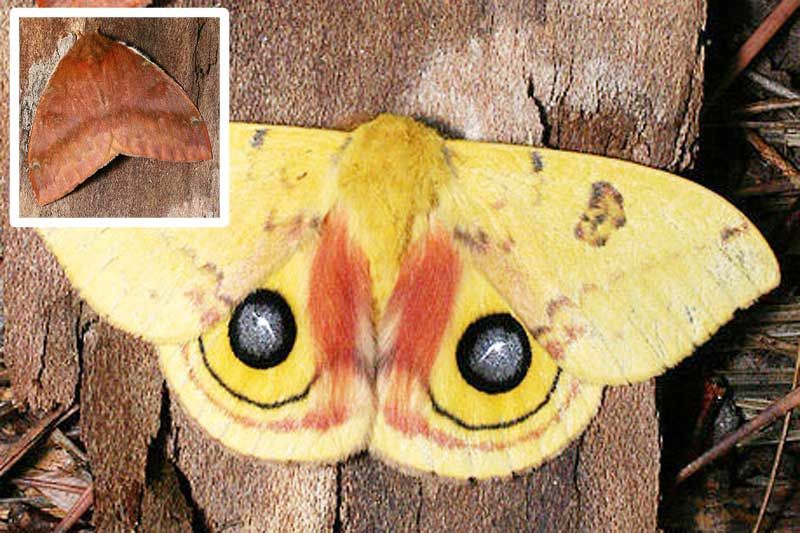Jul 17, 2014
By Steve Blight
This year I have seen more individual Io (pronounced EYE-oh) Moths than in all other summers combined. Likely this is because I am now able to spend more time in Io Moth country than in the past. Whatever the reason, I am happy to have seen so many. Io Moths are a strikingly colourful member of the Saturniidae family of moths, or giant silk moths, a family which also contains some of Canada’s biggest moths such as the beautiful Luna and Cecropia Moths.
Io Moths were named after a priestess from Greek mythology and are unmistakeable – with a wingspan of 5 to 9 centimetres (2 to 3 ½ inches) male forewings are usually bright yellow, while females have dark yellow or reddish-brown forewings. Both males and females have large spots that look like eyes on their mostly yellow hind-wings; these eyespots are black or blue, with a gray or bluish iris around a white centre.
Like other giant silk moths, adults do not eat – they don’t have fully formed mouth parts or digestive systems. When they emerge from their cocoons in early summer, adults have only one job to do during their 1 to 2 week lifespan – find a mate and make more Io Moths. To find a mate, female Io Moths release a chemical called a pheromone into the air which males detect with their sensitive feather-like antennae. According to one reliable source, female Io Moths have a specific time of night – 9:45 to10:30 pm – when they release the pheromones. This process is referred to as “calling” and the time appears to vary from one species of moth to another. Perhaps love-struck males are easily confused by the pheromones of different species and this helps them keep things straight. I wonder if males wait around impatiently checking their watches…
Even Io Moth caterpillars are interesting. Caterpillars go through five stages, or “instars”, during their lives as larvae. At first they stay together as a group, travelling about in lines (called queuing) and moulting into later instars by arranging themselves in circular patterns of caterpillars called rosettes. Older instars become more solitary and develop bristly spines along their bright green bodies that can cause irritation and pain to people who handle them. After about 4 weeks of feeding and moulting they spin their cocoons in leaf litter on the ground or in crevices among rocks or wood, emerging as adults the following year.
There is another interesting note about Io Moth caterpillar behaviour that I can’t resist describing. In queuing, as many as 40 caterpillars, gather and travel in a line. Each caterpillar has its head against the end of the individual in front of it, and they swing their heads back and forth, as if to make sure that they are still following the line. Researchers have found that the caterpillars can be placed in a continuous circle, and they will continue in this endless circle for hours, until one is blocked and changes direction, leading the line out of the circle!
Io Moths are native to eastern US and southern Canada, from eastern Manitoba through Ontario to western Quebec. Unlike many species of butterflies and moths that feed on a very narrow range of plant types, Io Moths feed on a variety of trees including willow, elm, birch and others, depending on what is available. Fortunately this beautiful and interesting moth is reported to still be quite common throughout its range, although some declines have been noted in the eastern US.
More Stories
- Burn Ban Off in North Frontenac, Addington Highlands - Reduced to Level One in South and Central Frontenac
- The Resurgent Sharbot Lake County Inn and Crossing Pub
- Towards Then End of Trail
- Silver Lake Pow Wow
- Central Frontenac Declares Former Office, Harvey Building, Surplus Properties
- Neighbours Could Lose The War Over Gravel Point - But Still Win The After Battle
- Sydenham Legion Bass Tournament
- From Performing Arts To The Written Word
- Legion Corner
- The Sun Shines On The Parham Fair

